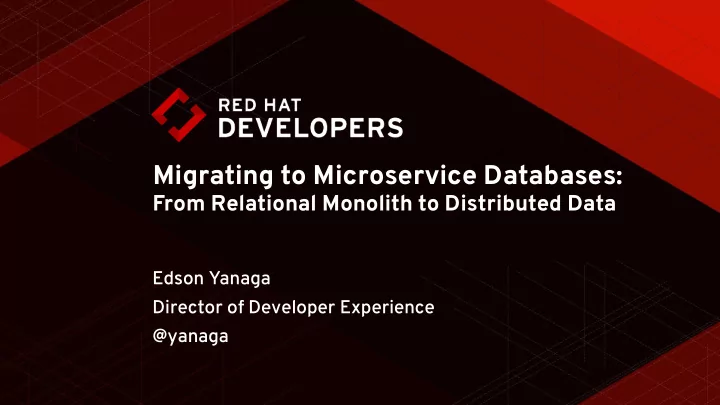

Migrating to Microservice Databases: From Relational Monolith to Distributed Data Edson Yanaga Director of Developer Experience @yanaga
Java Champion Microsoft MVP Join developers.redhat.com 2
http://developers.redhat.com/promotions/ migrating-to-microservice-databases
“Now, every company is a software company” — Forbes
Join developers.redhat.com 5
DevOps & Microservices
Feedback Loop
Batch Size
Maintenance Window Join developers.redhat.com 9
Zero Downtime
Blue Green Deployments Join developers.redhat.com 11
Deployment Join developers.redhat.com 12
Deployment Proxy Join developers.redhat.com 13
Blue Proxy Green Join developers.redhat.com 14
Blue Proxy Green Join developers.redhat.com 15
Blue Proxy Green Join developers.redhat.com 16
Blue Proxy Green Join developers.redhat.com 17
Code is easy, state is hard
What about my relational database?
Join developers.redhat.com 20
Zero Downtime Migrations
Back and Forward Compatibility
Baby Steps = Smallest Possible Batch Size
Too many rows = Long Locks
Shard your updates
ALTER TABLE customers RENAME COLUMN wrong TO correct; Join developers.redhat.com 26
ALTER TABLE customers ADD COLUMN correct VARCHAR(20); UPDATE customers SET correct = wrong WHERE id BETWEEN 1 AND 100; UPDATE customers SET correct = wrong WHERE id BETWEEN 101 AND 200; ALTER TABLE customers DELETE COLUMN wrong; Join developers.redhat.com 27
Scenarios Add a Column Rename a Column Change Type/Format of a Column Delete a Column Join developers.redhat.com 28
Add a Column 1 ADD COLUMN 2 Code computes the read value and writes to new column 3 Update data using shards 4 Code reads and writes from the new column Join developers.redhat.com 29
Rename a Column 1 ADD COLUMN 2 Code reads from the old column and writes to both 3 Copy data using small shards 4 Code reads from the new column and writes to both 5 Code reads and writes from the new column 6 Delete the old column (later) Join developers.redhat.com 30
Change Type/Format of a Column 1 ADD COLUMN 2 Code reads from the old column and writes to both 3 Copy data using small shards 4 Code reads from the new column and writes to both 5 Code reads and writes from the new column 6 Delete the old column (later) Join developers.redhat.com 31
Delete a Column 1 DON’T 2 Stop using the read value but keep writing to the column 3 Delete the column Join developers.redhat.com 32
What about referential integrity constraints?
Drop them and recreate when migration is done
Microservices Characteristics https://martinfowler.com/microservices/
Componentization via Services • Organized around Business Capabilities • Products not Projects • Smart endpoints and dumb pipes • Decentralized Governance • • Decentralized Data Management Infrastructure Automation • Design for failure • Evolutionary Design •
Extracting your Microservice database
One database per Microservice Join developers.redhat.com 38
But I have a monolithic database! Join developers.redhat.com 39
Join developers.redhat.com 40
Splitting is not easy, but how do I integrate later?
Consistency Models
Strong Consistency Eventual Consistency
CRUD & CQRS
CRUD (Create, Read, Update, Delete) Join developers.redhat.com 45
CQRS (Command Query Responsibility Segregation) Join developers.redhat.com 46
CQRS with separate data stores Join developers.redhat.com 47
CQRS & Event Sourcing
Scenarios Shared Tables Database View Database Materialized View Mirror Table using Trigger Mirror Table using Transactional Code Mirror Table using ETL Mirror Table using Data Virtualization Event Sourcing Change Data Capture Join developers.redhat.com 49
Shared Tables Fastest Data Integration Strong Consistency Low cohesion and high coupling Join developers.redhat.com 50
Database View Easiest one to implement Largest support from DBMS vendors Possible performance issues Strong Consistency One database must be reachable by the other Updatable depending on DBMS support Join developers.redhat.com 51
Database Materialized View Better performance Strong or Eventual Consistency One database must be reachable by the other Updatable depending on DBMS support Join developers.redhat.com 52
Database Trigger Depends on DBMS Support Strong Consistency One database must be reachable by the other Join developers.redhat.com 53
Transactional Code Any code: usually Stored Procedures or Distributed Transactions Strong Consistency Possible cohesion/coupling issues Possible performance issues Updatable depending on how it is implemented Join developers.redhat.com 54
ETL Tools Lots of available tools Requires external trigger (usually time-based) Can aggregate from multiple datasources Eventual Consistency Read only integration Join developers.redhat.com 55
Data Virtualization Real Time Access Strong Consistency Can aggregate from multiple datasources Updatable depending on Data Virtualization Platform Join developers.redhat.com 56
Join developers.redhat.com 57
Event Sourcing State of data is a stream of events Eases auditing Eventual Consistency Usually combined with a Message Bus High scalability Join developers.redhat.com 58
Change Data Capture Read datasource is updated through a stream of events Eventual Consistency Usually combined with a Message Bus High scalability Join developers.redhat.com 59
http://debezium.io
Join developers.redhat.com Feedback welcome! @yanaga
Thank you! plus.google.com/+RedHat facebook.com/redhatinc linkedin.com/company/red-hat twitter.com/RedHatNews youtube.com/user/RedHatVideos
Recommend
More recommend